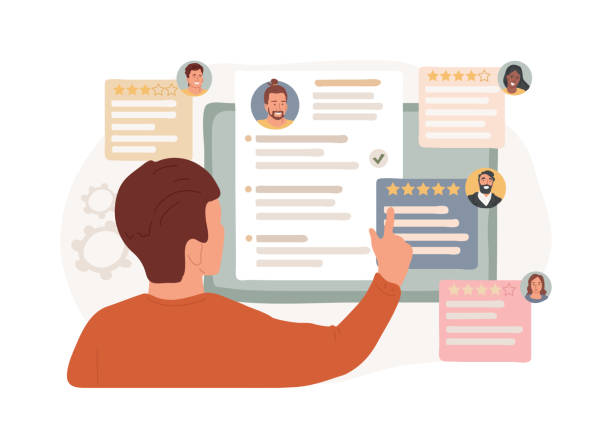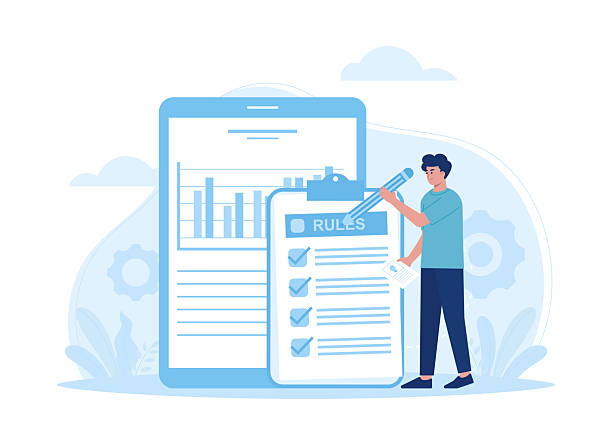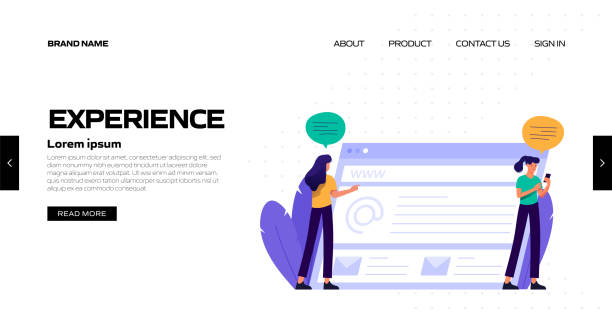Introduction and Importance of SEO-Optimized Website Design

In today’s digital world, having a website is just the first step; what truly matters is its visibility among a multitude of competitors.
This is where the concept of #SEO_optimized_website_design comes into play.
SEO-optimized website design means building a website that, from the outset, is created with SEO principles and search engine standards, especially Google, in mind.
The main goal of this approach is to ensure that the website ranks high in search results for keywords relevant to your field of activity.
This leads to increased organic traffic, greater brand credibility, and ultimately, business growth.
This section provides a deep and explanatory understanding of the foundations of SEO-optimized website design.
Without SEO, even the most beautiful and functional websites might get lost in the vast ocean of the internet and never reach their target audience.
Therefore, investing in a search engine optimized website design is not an option, but a vital necessity for any online business.
In the rest of this article, we will educationally explore various aspects of this topic and gradually familiarize you with its principles and techniques.
The importance of this process stems from the fact that over 90% of internet users begin their searches through search engines and usually only look at the first page of results.
So, if your website isn’t on the first page, you practically won’t exist for most searchers.
SEO-optimized website design not only helps with ranking but also improves user experience, which is itself an important factor in sustainable online success.
How much does losing business leads due to an unprofessional website cost you? Solve this problem forever with professional corporate website design by Rasaweb!
✅ Increase credibility and trust of potential customers
✅ Easier attraction of new business leads
⚡ Get free consultation now!
Basic SEO Principles in Web Design

To have an SEO-optimized website design, understanding basic SEO principles is of paramount importance.
These principles include technical, content, and backlink aspects, each playing a complementary role.
One of the most important foundations is technical website optimization.
This includes site loading speed, mobile-friendliness, appropriate URL structure, using an SSL certificate for security (HTTPS), and a logical hierarchical structure for pages.
A fast and responsive website that displays well on any device not only provides a better user experience but is also favored by search engines.
This section offers a specialized approach to optimized website design infrastructure.
Additionally, having a proper sitemap (Sitemap) and robots.txt file helps search engine crawlers index your website correctly.
High-quality and relevant content is also the backbone of any SEO-optimized website.
Target keywords should be naturally placed in the text, headings, and meta descriptions.
However, keyword stuffing, which was previously used, should be strictly avoided, as this practice can lead to penalties from search engines.
The heading structure (H1, H2, H3) should also be logical and relevant to the content.
An optimized web construction from the very beginning of the design ensures that your site progresses according to current search engine standards and will not require costly revisions in the future.
This is a comprehensive guide to starting the optimization journey.
Keyword Research and SEO-Optimized Content

Keyword research is the cornerstone of any SEO-optimized website design and effective content production.
This process involves identifying phrases and words that your target audience uses in search engines to find products, services, or information related to your business.
Without accurate keyword research, content creation is like shooting in the dark.
Tools such as Google Keyword Planner, Ahrefs, and SEMrush can help you discover keywords with suitable search volume and low competition.
This stage provides a deep analytical insight into the market and user needs.
After identifying keywords, the next step is to produce high-quality and relevant content.
SEO-optimized content should not only include target keywords but also be valuable, comprehensive, and responsive to user needs.
This involves creating blog articles, service pages, product descriptions, and other content that engages the audience and answers their questions.
Content quality is more important than quantity.
High-quality content can answer intriguing content questions from users and drive them towards you.
For example, if someone searches for “cheap website design,” your content should not only address this topic but also clarify the difference between “cheap” and “quality”.
| Tool | Capabilities | Strengths | Best for |
|---|---|---|---|
| Google Keyword Planner | Keyword suggestions, search volume, competition | Free, direct data from Google | Beginners, Google Ads campaigns |
| Ahrefs | Competitor analysis, backlink check, rank tracking, content analysis | Comprehensive, accurate, strong user interface | SEO specialists, digital marketing agencies |
| SEMrush | Competitor analysis, on-page and off-page SEO, PPC, social media | Multi-functional, wide coverage | Digital marketers, competitive analysts |
Technical Site Optimization for Search Engines

Technical site optimization is an integral part of an SEO-optimized website design and ensures that your website is accessible, understandable, and indexable for search engine crawlers.
Page loading speed is one of the most important technical factors that affects both user experience and is a critical ranking factor for Google.
Using optimized images, compressing CSS and JavaScript files, and utilizing a CDN (Content Delivery Network) are among the solutions for improving speed.
This is a practical guide to improving your site’s performance.
Also, mobile-friendliness (Mobile-First Indexing) means that Google primarily evaluates the mobile version of your site for indexing and ranking, so responsive design and mobile optimization are crucial.
Using structured data (Schema Markup) also helps search engines better understand your site’s content and display it in a richer way in search results (e.g., rating stars, prices, author names, etc.).
This specialized aspect of SEO is often considered by professional web designers.
Ensuring that the robots.txt file is correctly configured to prevent unnecessary pages from being indexed and that the XML sitemap is up-to-date so crawlers can find all your important pages is also very important.
Proper implementation of these technical elements provides a strong foundation for your website’s long-term SEO and ensures an SEO-optimized website design from the outset.
This process requires precise explanatory and executive knowledge to prevent technical issues that could affect the site’s ranking.
Is your e-commerce site ready to attract maximum customers and increase sales? Rasaweb transforms your online business with modern and efficient e-commerce website designs.
✅ Increased speed and improved SEO
✅ Excellent user experience on mobile and desktop⚡ Get a free e-commerce website design consultation from Rasaweb now!
The Role of User Experience (UX) in SEO

At first glance, there might not seem to be a direct connection between User Experience (UX) and SEO, but in reality, UX is a vital and hidden factor in SEO-optimized website design.
Google always seeks to provide the best experience to its users; therefore, websites that offer excellent user experience ultimately achieve better rankings.
If users quickly leave your site after entering (increased bounce rate) or spend little time on the site, these negative signals are sent to Google, indicating that your site was not useful for their search.
This section provides a key guide to improving bounce rate.
Factors such as ease of navigation, attractive visual design, content readability, loading speed, and mobile compatibility all influence user experience.
A website with strong UX encourages users to stay longer on the site, visit more pages, and interact with the content.
These positive interactions send positive signals to search engines and help improve SEO rankings.
Designing a website that is SEO-centric means that every aspect of it, including UX, should be optimized to be desirable for both users and search engines.
An engaging and comfortable user experience can turn users into loyal customers.
This synergy between SEO and UX indicates the evolution of Google’s algorithms, which now focus more than ever on user satisfaction.
Therefore, in the process of SEO-optimized website design, UX should not be overlooked; rather, it should be at the center of attention.
Link Building and Domain Authority Improvement

Link Building is another main pillar of an SEO-optimized website design and increasing your website’s Domain Authority.
Backlinks (links from other websites to yours) act like votes of confidence from other websites.
The greater the number and quality of backlinks pointing to your site, the more credible and trustworthy search engines will deem your site.
This section provides a specialized look at link-building strategies.
However, it should be noted that quality takes precedence over quantity; a backlink from a reputable and relevant website is worth far more than dozens of backlinks from low-quality or spammy websites.
Link-building strategies include creating shareable content, guest blogging, digital PR, and identifying broken links on other sites and suggesting replacing them with your own content.
This is a comprehensive guide to understanding the importance of link quality.
Google’s link guidelines are very strict, and any attempt to manipulate rankings through unnatural links can lead to penalties.
Therefore, the goal should be to create natural, high-quality links that are earned organically, not bought.
Increasing domain authority through proper link building gives your site more power in rankings and makes it more visible in search results.
This process is an inseparable part of creating a search engine optimized website.
Local and International SEO

When it comes to SEO-optimized website design, it’s important to understand the differences between Local SEO and International SEO.
Local SEO is crucial for businesses that serve customers in a specific geographic area.
This includes optimizing for searches such as “best restaurant in Tehran” or “computer repair in Isfahan.”
The most important aspect of local SEO is optimizing your Google My Business profile, which includes accurate business information, customer reviews, and images.
This is a complete explanation of how local SEO works.
Also, ensuring NAP (Name, Address, Phone Number) consistency across your website and online directories is very important.
This section might also include news about recent changes in Google’s local SEO algorithms.
| Feature | Local SEO | International SEO |
|---|---|---|
| Main Goal | Attracting customers in a specific geographical area | Targeting global markets and users in different countries |
| Key Tools | Google My Business, local directories | Hreflang tags, TLD domains (e.g., .com, .ir), content translation |
| Keywords | Includes city or region name (e.g., “Sa’adat Abad coffee shop”) | Varies depending on the language and culture of each country |
| Practical Example | A restaurant seeking customers in its city. | A company with global services looking to attract customers from multiple countries. |
In contrast, International SEO pertains to websites that aim to attract audiences in multiple countries or different geographical regions with various languages.
This involves using hreflang tags to specify the appropriate language version of each page, selecting a suitable URL structure (such as country-specific domains or language subdirectories), and translating and localizing content.
An SEO-optimized website design for global audiences must consider all these points to benefit from targeted traffic from different parts of the world.
International SEO has its unique challenges, including cultural and linguistic differences in keywords and content, and the need to understand local laws and regulations.
This requires a specialized and precise approach.
Crucial Tools for SEO-Optimized Website Design

For anyone involved in SEO-optimized website design, using the right tools not only makes the job easier but also aids in more precise analysis and data-driven decision-making.
These tools can be useful at every stage of the SEO process, from keyword research to performance monitoring and competitor analysis.
Google Search Console (GSC) and Google Analytics (GA) are two free and essential tools from Google itself.
GSC helps you identify technical site issues, monitor your search performance, and ensure pages are indexed correctly.
GA also provides detailed information about site traffic, user behavior, and traffic sources.
These tools are an educational and specialized resource for every webmaster and SEO specialist.
There are also more advanced paid tools such as Ahrefs, SEMrush, Moz, and KWFinder, which offer broader capabilities including advanced keyword research, backlink analysis, competitor rank checking, site SEO auditing, and campaign performance monitoring.
Choosing the right tool depends on your budget, needs, and expertise level.
However, the important point is that merely having these tools is not enough; one must learn how to use them correctly and analyze the data they provide to effectively move towards SEO-optimized website design.
These tools help you gain a deep analytical insight and make better decisions.
Is your online sales not as you expect? With Rasaweb, solve the problem of low sales and poor user experience forever!
✅ Increase visitor-to-customer conversion rate
✅ Create an enjoyable user experience and boost customer trust⚡ Act now to get a free consultation!
Monitoring and Analyzing SEO Performance

After your website is launched with an SEO-optimized website design and SEO strategies are implemented, your work is not over.
SEO is an ongoing process and requires continuous monitoring and analysis of performance.
This stage is vital for evaluating the effectiveness of your efforts, identifying potential problems, and adjusting your strategy based on real data.
Tools like Google Search Console and Google Analytics play a pivotal role at this stage.
You should regularly review organic traffic, keyword rankings, bounce rate, user time spent on the site, and user conversion paths.
A thorough analysis will show you which pages are performing well and which areas need improvement.
This is an analytical look at your site’s performance.
Answering questions like “Why has the traffic to a particular page decreased?” or “Why do users abandon the site at a specific stage of the purchase process?” requires deep analysis and thought-provoking content.
Additionally, you should monitor competitor performance and stay informed about changes in Google’s algorithms to quickly adapt your SEO strategy.
Continuous monitoring allows you to identify new growth opportunities and prevent any drops in ranking or traffic.
This monitoring and analysis process is an inseparable part of maintaining an SEO-optimized website design and ensuring its long-term success.
An SEO-centric website is always improving.
The Future of SEO-Optimized Website Design and New Trends

The world of SEO and SEO-optimized website design is constantly changing and evolving.
Search engine algorithms are continuously updated, and new trends emerge that SEO specialists must always keep up with.
One of the most important future trends is an increased focus on Voice Search and Artificial Intelligence (AI).
With the increasing use of voice assistants like Siri and Alexa, optimizing content to answer natural language questions is becoming increasingly important.
AI is also changing how search engines understand and rank content and can help improve user experience and personalize search results.
This is news from the future of SEO.
Video SEO and Image SEO will also gain more importance, as visual content accounts for a larger share of online consumption.
Furthermore, with the advent of Web 3.0 and the Metaverse, the way users interact with the internet and search engines may undergo fundamental changes.
This has entertaining potential for the future.
For an SEO-optimized website design to remain effective in the future, it must be flexible and able to adapt to these changes.
This includes continuously updating SEO knowledge, experimenting with new strategies, and investing in emerging technologies.
SEO specialists must think beyond traditional techniques and seek creative ways to provide the best experience for both users and search engines.
These trends indicate that SEO is not just a technical skill, but a specialized and dynamic art that is constantly evolving.
Frequently Asked Questions
| Question | Answer |
|---|---|
| What is SEO-optimized website design? | SEO-optimized website design means designing and coding a website that is technically, content-wise, and structurally optimized so that search engines can easily crawl, index, and assign a higher ranking to it in search results. |
| Why is SEO-optimized website design important? | Its importance lies in increasing website visibility in search engine results (like Google), attracting more organic traffic, improving user experience, and ultimately increasing conversion rates (sales or desired actions). |
| What are the most important technical SEO factors in website design? | High loading speed, responsiveness (Mobile-Friendly), proper URL structure, use of SSL certificate (HTTPS), XML sitemap, and robots.txt file. |
| What impact does Responsive Design have on SEO? | Since most searches are done via mobile, Google prioritizes responsive sites. Responsive design improves user experience and reduces bounce rate, both of which help SEO. |
| How does website loading speed affect SEO? | Loading speed is an important ranking factor for Google. Slow sites lead to poor user experience, increased bounce rate, and lower rankings in search results. |
| What is the role of URL structure in SEO? | Short, readable URLs that include relevant keywords help both users and search engines better understand the page’s topic, and this positively impacts SEO. |
| What is the importance of using Title Tags and Meta Descriptions in SEO design? | These tags provide information about the page’s content to search engines and users. Optimizing them with appropriate keywords increases click-through rate (CTR) and improves content understanding by search bots. |
| What is the importance of Image Optimization in SEO? | Reducing image size to increase site speed, using descriptive Alt tags (including keywords) to describe the image to search engines, and increasing the chance of appearing in Google Image Search. |
| How does Internal Linking help SEO? | Internal linking helps search engines better understand the site’s structure, distributes authority (PageRank) across the site, and directs users to relevant pages, which improves user experience and reduces bounce rate. |
| What is the relationship between User Experience (UX) and SEO? | Google values websites that provide a good user experience. Attractive visual design, easy navigation, readable content, and high speed all contribute to improved UX, which in turn leads to a reduced bounce rate, increased time on site, and positive signals to search engines. |
And other services of Rasaweb Advertising Agency in the field of advertising
Smart Data Analysis: A specialized service for growth in customer acquisition based on attractive UI design.
Smart Direct Marketing: A combination of creativity and technology for user interaction through SEO-centric content strategy.
Smart Link Building: Professional optimization for increasing website traffic using precise audience targeting.
Smart Marketplace: A professional solution for campaign management with a focus on precise audience targeting.
Smart Marketing Automation: A specialized service for growing user engagement based on precise audience targeting.
And over a hundred other services in the field of internet advertising, advertising consultation, and organizational solutions
Internet Advertising | Advertising Strategy | Advertorial
Resources
SEO Basics for a Successful Start
Website Design Principles for Better Performance
Content Marketing and Its Role in SEO
User Experience (UX) and Its Impact on SEO
? To boost your business in the digital world, count on “Rasaweb Afarin”‘s expertise! By providing comprehensive digital marketing services, including multilingual website design, we help you establish a powerful and influential online presence.
📍 Tehran, Mirdamad Street, next to Bank Markazi, Southern Kazerun Alley, Ramin Alley, No. 6

